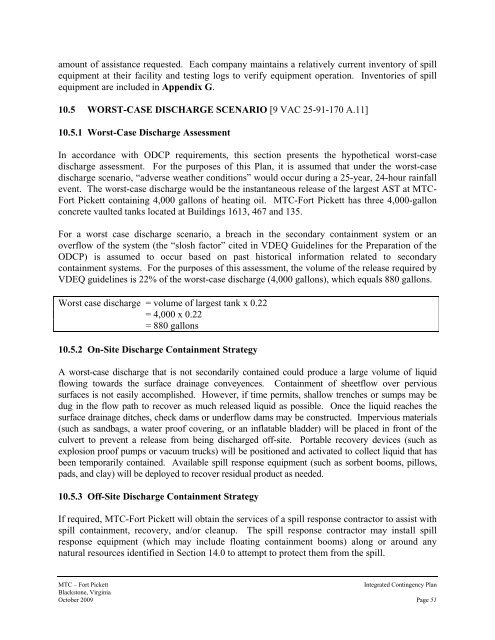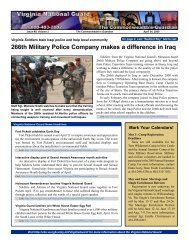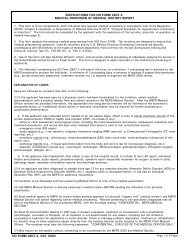INTEGRATED CONTINGENCY PLAN Maneuver Training Center
integrated contingency plan maneuver training center fort pickett ...
integrated contingency plan maneuver training center fort pickett ...
- No tags were found...
You also want an ePaper? Increase the reach of your titles
YUMPU automatically turns print PDFs into web optimized ePapers that Google loves.
amount of assistance requested. Each company maintains a relatively current inventory of spill<br />
equipment at their facility and testing logs to verify equipment operation. Inventories of spill<br />
equipment are included in Appendix G.<br />
10.5 WORST-CASE DISCHARGE SCENARIO [9 VAC 25-91-170 A.11]<br />
10.5.1 Worst-Case Discharge Assessment<br />
In accordance with ODCP requirements, this section presents the hypothetical worst-case<br />
discharge assessment. For the purposes of this Plan, it is assumed that under the worst-case<br />
discharge scenario, “adverse weather conditions” would occur during a 25-year, 24-hour rainfall<br />
event. The worst-case discharge would be the instantaneous release of the largest AST at MTC-<br />
Fort Pickett containing 4,000 gallons of heating oil. MTC-Fort Pickett has three 4,000-gallon<br />
concrete vaulted tanks located at Buildings 1613, 467 and 135.<br />
For a worst case discharge scenario, a breach in the secondary containment system or an<br />
overflow of the system (the “slosh factor” cited in VDEQ Guidelines for the Preparation of the<br />
ODCP) is assumed to occur based on past historical information related to secondary<br />
containment systems. For the purposes of this assessment, the volume of the release required by<br />
VDEQ guidelines is 22% of the worst-case discharge (4,000 gallons), which equals 880 gallons.<br />
Worst case discharge = volume of largest tank x 0.22<br />
= 4,000 x 0.22<br />
= 880 gallons<br />
10.5.2 On-Site Discharge Containment Strategy<br />
A worst-case discharge that is not secondarily contained could produce a large volume of liquid<br />
flowing towards the surface drainage conveyences. Containment of sheetflow over pervious<br />
surfaces is not easily accomplished. However, if time permits, shallow trenches or sumps may be<br />
dug in the flow path to recover as much released liquid as possible. Once the liquid reaches the<br />
surface drainage ditches, check dams or underflow dams may be constructed. Impervious materials<br />
(such as sandbags, a water proof covering, or an inflatable bladder) will be placed in front of the<br />
culvert to prevent a release from being discharged off-site. Portable recovery devices (such as<br />
explosion proof pumps or vacuum trucks) will be positioned and activated to collect liquid that has<br />
been temporarily contained. Available spill response equipment (such as sorbent booms, pillows,<br />
pads, and clay) will be deployed to recover residual product as needed.<br />
10.5.3 Off-Site Discharge Containment Strategy<br />
If required, MTC-Fort Pickett will obtain the services of a spill response contractor to assist with<br />
spill containment, recovery, and/or cleanup. The spill response contractor may install spill<br />
response equipment (which may include floating containment booms) along or around any<br />
natural resources identified in Section 14.0 to attempt to protect them from the spill.<br />
MTC – Fort Pickett<br />
Integrated Contingency Plan<br />
Blackstone, Virginia<br />
October 2009 Page 51
















